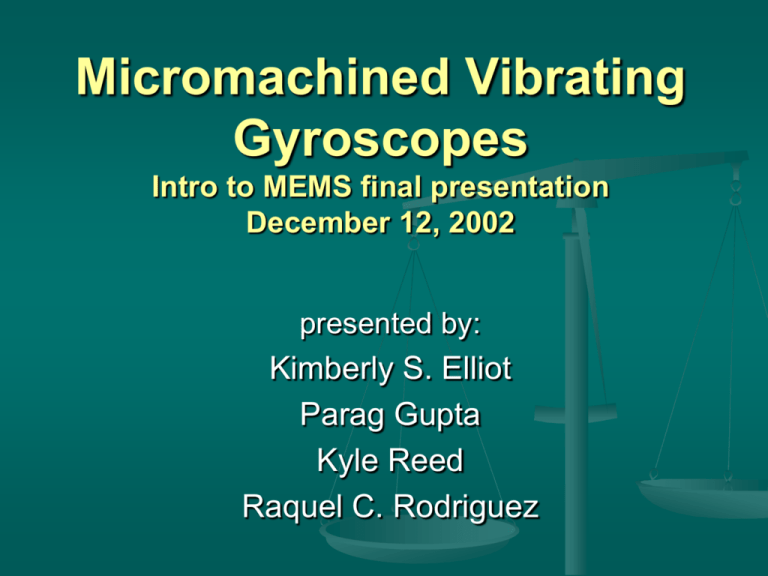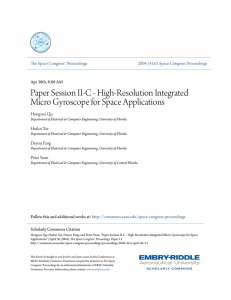Tiny Little Gyroscopes Intro to MEMS final presentation December
advertisement

Micromachined Vibrating Gyroscopes Intro to MEMS final presentation December 12, 2002 presented by: Kimberly S. Elliot Parag Gupta Kyle Reed Raquel C. Rodriguez Presentation Outline State-of-the-art review Two case studies Introduction / Applications Operation Principles HARPSS Vibrating Ring Draper’s Tuning Fork Conclusions and Questions Introduction Performance of micromachined gyroscopes improves by a factor of 10x every two years since 1991. Applications: automotive ride stabilization and rollover detection. Applications (Cont’d) Guidance and Navigation Segway Scooter Uses five MEMS gyroscopes for tilt and rotation detection. Basic Operating Principles Follows Newton’s Laws Force required to change velocity Resistance to change in velocity increases with mass Gyroscope provides information about angular orientation. Three types of Gyros: Spinning Mass – tilting produces precession Optical – measure time differences in laser paths Impractical in MEMS Very expensive, but also the best performance Vibrating – based on Coriolis effect The most common Basic Configuration of Vibrating Gyroscopes Four main components: Proof mass Elastic spring Dashpot Sensing method Proof mass is put into oscillation (x-axis) Sensitive to angular rotation in the z-axis Induced Coriolis acceleration (y- axis) Vibrating Gyroscope Basics Coriolis Acceleration: Fc = 2mv Fc – Coriolis force m – vibratory mass v – linear velocity - angular rotation Two degrees of freedom are required: drive and sense. Most common sensing methods: Capacitive Piezoresistive Performance concepts Scale factor: amount of change in output per unit change rotation [V/(/s)] • Zero-rate output (ZRO): output in the absence of angular rate, it’s the sum of white noise and a slowly varying function • Noise defines resolution [(/s)/Hz] • Slowly varying function defines drift [/s] HARPSS Vibrating Ring Gyroscope High Aspect-Ratio Combined Poly and Single-Crystal Silicon. Developed at The University of Michigan. Vibrating ring and eight support springs. Each spring with two electrodes for drive and sensing, and to compensate asymmetries. Capacitive sensing. Vibrating Ring Symmetric design: Identical drive and sense flexural modes 45 apart Same resonant frequency Less temperature sensitive Q directly amplifies sensitivity Filters spurious vibrations Sense mode amplitude: qsense = 4Ag.Q/0.qdrive.z Ag 0.37 – structure angular gain; Q – structure quality factor; 0 – flexural resonance frequency; qdrive – drive vibration amplitude; z – rotation rate. Fabrication of HARPSS 1 Deposit and pattern a thin layer of LPCVD silicon nitride. Dry etch using Deep Reactive Ion Etch (DRIE). This serves as an isolation dielectric layer. Forms deep trenches with smooth and straight sidewalls. Deposit a sacrificial oxide layer. Refill the trenches with polysilicon. Dope the polysilicon layer with boron to speed its etch rate Fabrication of HARPSS 2 Deposit and pattern Cr/Au. Dry directional/isotropic SF6 silicon etch to release silicon sense electrodes. Involves a deep, directional etch followed by an isotropic SF6 silicon etch. Using HF:H2O, etch away the sacrificial oxide Creates capacitive air gaps between the sense-electrodes and the ring structure. HARPSS Gyroscope Advantages: • Small ring-to-electrode gap Large structural height Better structural material Sensitivity 200 [V/(/s)] For Q 1200, resolution 0.01 [/s] for 1 Hz bandwidth Min.detectable signal 5x10-3 [/s] for 10 Hz bandwidth HARPSS Limitations Anchor problem: excessive undercut of the substrate at the post causes the oxide to be exposed and etched away resulting in a soft anchor that dissipates energy. HARPSS Limitations 2 Voids and keyholes generated during the polysilicon refill process RIE lag effect: height of high aspect narrow trenches is less than for the medium and wide ones. Basic Tuning Fork Gyroscope Tines resonated to fixed amplitude. When rotated, Coriolis force causes a sinusoidal force on tines. This force detected as a bending of the tines or as a torsional vibration i of junction bar. Capacitive, piezoresistive, or piezoelectric detection mechanisms. Draper’s Tuning Fork Masses Beams Comb Structure Developed by Charles Stark Draper Laboratory. Two masses suspended by beams. Electrostatically vibrated using comb drives. Generates a Coriolis force that pushes masses in and out of oscillation plane. Measured by capacitor plates. Fabrication of Tuning Fork 1 Dissolved wafer process involving both silicon and glass processing. P-type (100) silicon wafer of moderate doping (>1-cm) is used. Mask 1: Etch recess with KOH to define the height of the silicon above the glass. Diffuse Boron at 1175 C to define thickness. Mask 2: Reactive ion etch (RIE). Defines the structure’s pattern features. Fabrication of Tuning Fork 2 Glass wafer processed separately. Mask 3: Recess glass 1600 Angstroms. Deposit and lift off a multi-metal system. Result: Metal protrudes 500 Angstroms above the glass. The metal forms the sense and drive plates of the capacitor and the output leads from the transducer. Fabrication of Tuning Fork 3 Silicon wafer is turned upside down and electrostatically bonded to the glass. 375C and potential of 1000 V for strong chemical bonds. Silicon and glass drawn tightly together to ensure a low resistance contact to silicon. Final step: Selective EDP etch to dissolve the undoped silicon. Draper’s Gyroscope • Robustness, withstands accelerations of 60,000 g’s Scale factor > 200 ppm Bias uncertainty < 50 /hr Drift 0.05 /s • Low temperature: 0.003 /s • Resolution 100-200 /hr (60 Hz bandwidth) • Best: 25 /hr Conclusions Early development phase for micromachined gyroscopes. HARPSS yields a gyroscope with excellent mode matching, high resolution, low ZRO and long-term stability. Draper Lab produces a low-cost gyroscope of small size and considerable ruggedness. Any Questions?







